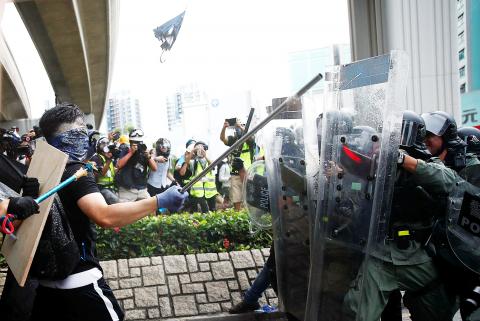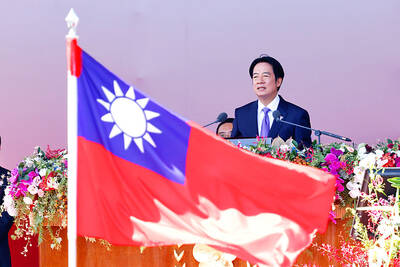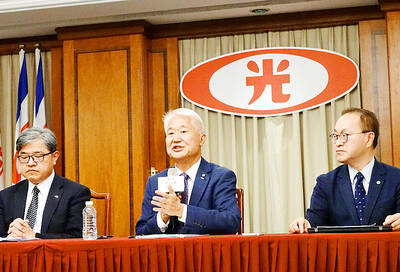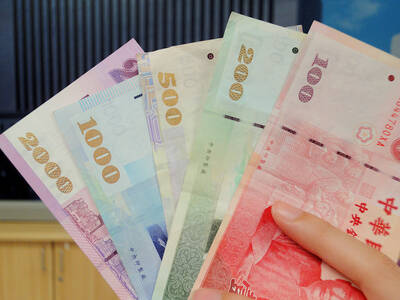Hong Kong police yesterday fired tear gas at protesters holding a banned rally against suspected triad gangs who beat up pro-democracy demonstrators near the Chinese border on Sunday last week.
Riot police fired dozens of rounds of tear gas in Yuen Long after tense standoffs with protesters, some of whom were throwing projectiles and had surrounded a police van.
Public anger has been raging since Sunday, when a gang of men in white T-shirts, armed with poles and batons, set upon protesters and bystanders in Yuen Long Station.

Photo: Reuters
Police have been heavily criticized for being too slow to respond to Sunday’s violence, fueling accusations of collusion or turning a blind eye — allegations the force has denied.
Yesterday’s violence compounds the political crisis with the territory’s pro-Beijing leadership seemingly unable — or unwilling — to end the chaos.
Yuen Long is in Hong Kong’s New Territories, a rural area where many of the surrounding villages are known for triad connections and their staunch support for the pro-Beijing establishment.

Photo: EPA-EFE
Police say they have arrested 12 people so far in connection with Sunday’s violence, nine of whom have known triad links.
The white shirt mob ran into two villages near Yuen Long MTR Station after their attack and later left without police making any arrests, despite a large presence of officers.
These two villages became the focus of protester anger yesterday.
The rally began peacefully, but small groups, many in helmets and carrying shields, confronted police outside the villages and accused them of protecting triads.
Tensions soon escalated with projectiles hurled and a police van containing officers surrounded and daubed in graffiti.
Soon tear gas rounds were arcing through the air and a now-familiar pattern of running battles between police and protesters began.
Throughout the afternoon protesters formed shield walls of umbrellas, scattering each time new volleys of tear gas came their way.
In a rare move, police banned the rally, saying that they feared reprisal attacks against villagers from protesters, a decision that only heightened anger toward a force already perceived to be protecting pro-government aggressors.
Social messaging channels used to organize the largely leaderless movement quickly filled up with calls for people to have a “shopping spree” in Yuen Long or play Pokemon Go there.
Crowds spilled out of Yuen Long’s main station in the afternoon as the illegal march began peacefully. Many shops were shuttered.
“Every one of us came here on our own initiation,” a 25-year-old medical worker surnamed Ng said. “So I don’t think this is an illegal assembly. I’ve just come here as an individual to tell people my thoughts.”
Weeks of protests with huge turnouts have had little luck persuading Beijing or Hong Kong’s leaders. Beijing has issued increasingly shrill condemnations, but has left it to the territory’s government to deal with the situation.
Hong Kong Chief Executive Carrie Lam (林鄭月娥) has shown no sign of backing down beyond agreeing to suspend the extradition bill.
Protesters also plan to march today through a district where riot police fired tear gas and rubber bullets at projectile-hurling protesters the week before.
Police have allowed a rally to take place, but denied protesters permission to march, raising the likelihood of further confrontations.

People can preregister to receive their NT$10,000 (US$325) cash distributed from the central government on Nov. 5 after President William Lai (賴清德) yesterday signed the Special Budget for Strengthening Economic, Social and National Security Resilience, the Executive Yuan told a news conference last night. The special budget, passed by the Legislative Yuan on Friday last week with a cash handout budget of NT$236 billion, was officially submitted to the Executive Yuan and the Presidential Office yesterday afternoon. People can register through the official Web site at https://10000.gov.tw to have the funds deposited into their bank accounts, withdraw the funds at automated teller

PEACE AND STABILITY: Maintaining the cross-strait ‘status quo’ has long been the government’s position, the Ministry of Foreign Affairs said Taiwan is committed to maintaining the cross-strait “status quo” and seeks no escalation of tensions, the Ministry of Foreign Affairs (MOFA) said yesterday, rebutting a Time magazine opinion piece that described President William Lai (賴清德) as a “reckless leader.” The article, titled “The US Must Beware of Taiwan’s Reckless Leader,” was written by Lyle Goldstein, director of the Asia Program at the Washington-based Defense Priorities think tank. Goldstein wrote that Taiwan is “the world’s most dangerous flashpoint” amid ongoing conflicts in the Middle East and Russia’s invasion of Ukraine. He said that the situation in the Taiwan Strait has become less stable

CONCESSION: A Shin Kong official said that the firm was ‘willing to contribute’ to the nation, as the move would enable Nvidia Crop to build its headquarters in Taiwan Shin Kong Life Insurance Co (新光人壽) yesterday said it would relinquish land-use rights, or known as surface rights, for two plots in Taipei’s Beitou District (北投), paving the way for Nvidia Corp to expand its office footprint in Taiwan. The insurer said it made the decision “in the interest of the nation’s greater good” and would not seek compensation from taxpayers for potential future losses, calling the move a gesture to resolve a months-long impasse among the insurer, the Taipei City Government and the US chip giant. “The decision was made on the condition that the Taipei City Government reimburses the related

FRESH LOOK: A committee would gather expert and public input on the themes and visual motifs that would appear on the notes, the central bank governor said The central bank has launched a comprehensive redesign of New Taiwan dollar banknotes to enhance anti-counterfeiting measures, improve accessibility and align the bills with global sustainability standards, Governor Yang Chin-long (楊金龍) told a meeting of the legislature’s Finance Committee yesterday. The overhaul would affect all five denominations — NT$100, NT$200, NT$500, NT$1,000 and NT$2,000 notes — but not coins, Yang said. It would be the first major update to the banknotes in 24 years, as the current series, introduced in 2001, has remained in circulation amid rapid advances in printing technology and security standards. “Updating the notes is essential to safeguard the integrity